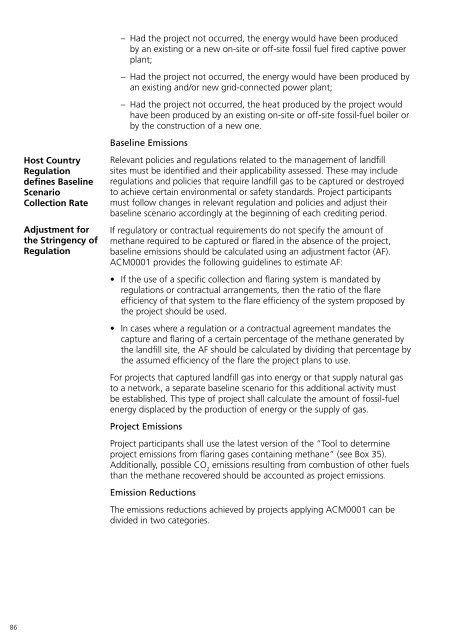Understanding CDM Methodologies - SuSanA
Understanding CDM Methodologies - SuSanA
Understanding CDM Methodologies - SuSanA
Create successful ePaper yourself
Turn your PDF publications into a flip-book with our unique Google optimized e-Paper software.
– Had the project not occurred, the energy would have been produced<br />
by an existing or a new on-site or off-site fossil fuel fired captive power<br />
plant;<br />
– Had the project not occurred, the energy would have been produced by<br />
an existing and/or new grid-connected power plant;<br />
– Had the project not occurred, the heat produced by the project would<br />
have been produced by an existing on-site or off-site fossil-fuel boiler or<br />
by the construction of a new one.<br />
Baseline Emissions<br />
Host Country<br />
Regulation<br />
defines Baseline<br />
Scenario<br />
Collection Rate<br />
Adjustment for<br />
the Stringency of<br />
Regulation<br />
Relevant policies and regulations related to the management of landfill<br />
sites must be identified and their applicability assessed. These may include<br />
regulations and policies that require landfill gas to be captured or destroyed<br />
to achieve certain environmental or safety standards. Project participants<br />
must follow changes in relevant regulation and policies and adjust their<br />
baseline scenario accordingly at the beginning of each crediting period.<br />
If regulatory or contractual requirements do not specify the amount of<br />
methane required to be captured or flared in the absence of the project,<br />
baseline emissions should be calculated using an adjustment factor (AF).<br />
ACM0001 provides the following guidelines to estimate AF:<br />
• If the use of a specific collection and flaring system is mandated by<br />
regulations or contractual arrangements, then the ratio of the flare<br />
efficiency of that system to the flare efficiency of the system proposed by<br />
the project should be used.<br />
• In cases where a regulation or a contractual agreement mandates the<br />
capture and flaring of a certain percentage of the methane generated by<br />
the landfill site, the AF should be calculated by dividing that percentage by<br />
the assumed efficiency of the flare the project plans to use.<br />
For projects that captured landfill gas into energy or that supply natural gas<br />
to a network, a separate baseline scenario for this additional activity must<br />
be established. This type of project shall calculate the amount of fossil-fuel<br />
energy displaced by the production of energy or the supply of gas.<br />
Project Emissions<br />
Project participants shall use the latest version of the “Tool to determine<br />
project emissions from flaring gases containing methane” (see Box 35).<br />
Additionally, possible CO 2<br />
emissions resulting from combustion of other fuels<br />
than the methane recovered should be accounted as project emissions.<br />
Emission Reductions<br />
The emissions reductions achieved by projects applying ACM0001 can be<br />
divided in two categories.<br />
86

















